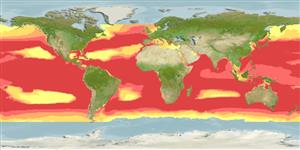Ikan bertulang rawan (sharks and rays) >
Lamniformes (Mackerel sharks) >
Lamnidae (Mackerel sharks or white shark)
Etymology: Isurus: isos (Gr.), equal; oura (Gr.), tail, referring to caudal-fin lobes of I. oxyrinchus being equal in length (except that they are not; the upper is clearly longer). (See ETYFish); oxyrinchus: oxys (Gr.), sharp or pointed; rynchus (L.), snout, referring to its pointed snout. (See ETYFish).
More on author: Rafinesque.
Environment: milieu / climate zone / depth range / distribution range
Ekologi
laut; oceanodromus (Ref. 51243); kisaran kedalaman 0 - 888 m (Ref. 106604), usually 100 - 150 m (Ref. 36731). Subtropical; 16°C - ? (Ref. 9988); 65°N - 54°S, 180°W - 180°E
Cosmopolitan in temperate and tropical seas (Ref. 6871, 11230). Western Atlantic: Gulf of Maine to southern Brazil and Argentina (Ref. 58839), including the Gulf of Mexico and Caribbean. Eastern Atlantic: Norway to South Africa, including the Mediterranean. Indo-Pacific: East Africa to Hawaii, north to Primorskiy Kray (Russian Federation), south to Australia and New Zealand. Eastern Pacific: south of Aleutian Islands and from southern California, USA to Chile.
Length at first maturity / Size / Weight / umur
Maturity: Lm 278.3, range 275 - 285 cm
Max length : 445 cm TL jantan/; (Ref. 106604); common length : 270 cm TL jantan/; (Ref. 5217); Berat maksimum terpublikasi: 505.8 kg (Ref. 4699); Umur maksimum dilaporkan: 32 Tahun (Ref. 86588)
Duri punggung (Keseluruhan (total)): 0; duri punggung lunak (Keseluruhan (total)): 0; Duri dubur 0; Sirip dubur lunak: 0. A large, spindle-shaped shark with large black eyes, a sharp snout, and large, narrow, hooked teeth with smooth edges (Ref. 5578). Caudal fin lunate, lower lobe strongly developed (Ref. 13574). Dark blue above, white below (Ref. 6581). Tiny second dorsal and anal fins (Ref. 26938).
Oceanic, but sometimes found close inshore (Ref. 6871, 11230, 58302). Usually in surface waters (Ref. 30573), down to about 150 m (Ref. 26938, 11230). Coastal, epipelagic at 1->500 m (Ref. 58302). Isotope analysis has shown that shortfin mako is the highest level fish predator in oceanic waters off eastern Australia (Ref. 86961). Adults feed on bony fishes, other sharks (Ref. 5578), cephalopods; larger individuals may feed on larger prey such as billfish and small cetaceans (Ref. 6871, 58048). Ovoviviparous, embryos feeding on yolk sac and other ova produced by the mother (Ref. 43278, 50449). With 4-16 young of about 60-70 cm long (Ref. 35388, 26346). Gestation period lasts 15-18 months, spawning cycle is every 3 years. Some authors (Refs. 1661, 28081, 31395) have erroneously assumed that two age rings are deposited per year by this species, thus underestimating longevity, age at maturity, and resilience . These data have been removed and replaced by recent, verified estimates (Refs. 86586, 86587, 86588). Tagging in New Zealand indicates seasonal migrations (Ref. 26346). The presence of genetic differentiation in mitochondrial DNA across global populations (Ref. 36416) suggests dispersal may be male-biased, and that females may have natal site-fidelity. Shortfin mako has been shown to have a marked sexually segregated population structure (Ref. 86954). Shortfin mako is probably the fastest of all sharks and can leap out of the water when hooked (Ref. 6871). Potentially dangerous and responsible for unprovoked attacks on swimmers and boats (Ref. 13574). Utilized fresh, dried or salted, smoked and frozen; eaten broiled and baked (Ref. 9988). Valued for its fine quality meat as well as its fins and skin (Ref. 247). Oil is extracted for vitamins and fins for shark-fin soup (Ref. 13574). Jaws and teeth are also sold as ornaments and trophies (Ref. 9988). by Kabasakal & de Maddalena, 2011 reported a historical record of a larger specimen, caught in the Mediterranean Sea off Turkey, about 585 cm (TL estimated from photographs) (Ref. 106604). Maximum depth from Ref. 125614.
Exhibit ovoviparity (aplacental viviparity), with embryos feeding on other ova produced by the mother (oophagy) after the yolk sac is absorbed (Ref. 50449). With up to 18 young in a litter (Ref. 26346). Gives birth to litters of 4-25 (usually 10-18) pups after a gestation period of 15-18 months; reproduces every 3 years (Ref.58048). Size at birth between 60 and 70 cm (Ref. 247). Distinct pairing with embrace (Ref. 205).
Compagno, L.J.V., 1984. FAO Species Catalogue. Vol. 4. Sharks of the world. An annotated and illustrated catalogue of shark species known to date. Part 1 - Hexanchiformes to Lamniformes. FAO Fish. Synop. 125(4/1):1-249. Rome, FAO. (Ref. 247)
Status IUCN Red List (Ref. 130435)
penggunaan manusia
Perikanan: nilai komersial kecil; Ikan buruan: ya
Alat, peralatan
laporan khas
muat turun XML
Sumber internet
Estimates based on models
Preferred temperature (Ref.
123201): 9.7 - 24.4, mean 17.4 °C (based on 598 cells).
Phylogenetic diversity index (Ref.
82804): PD
50 = 0.7813 [Uniqueness, from 0.5 = low to 2.0 = high].
Bayesian length-weight: a=0.00646 (0.00386 - 0.01080), b=3.03 (2.88 - 3.18), in cm total length, based on LWR estimates for this species & (Sub)family-body (Ref.
93245).
Trophic level (Ref.
69278): 4.5 ±0.0 se; based on diet studies.
Daya lenting (Ref.
120179): Rendah, Waktu penggandaan populasi minimum 4.5 - 14 tahun (rm=0.051; tm=8-20; tmax=32; Fec=4).
Prior r = 0.24, 95% CL = 0.11 - 0.54, Based on 3 stock assessments.
Fishing Vulnerability (Ref.
59153): Very high vulnerability (79 of 100).
Climate Vulnerability (Ref.
125649): High vulnerability (62 of 100).
Nutrients (Ref.
124155): Calcium = 7.24 [2.04, 36.21] mg/100g; Iron = 0.713 [0.180, 2.070] mg/100g; Protein = 20.7 [18.3, 22.9] %; Omega3 = 0.383 [0.157, 0.916] g/100g; Selenium = 35.5 [11.1, 99.0] μg/100g; VitaminA = 6.35 [2.11, 19.61] μg/100g; Zinc = 0.32 [0.16, 0.59] mg/100g (wet weight); based on
nutrient studies.
